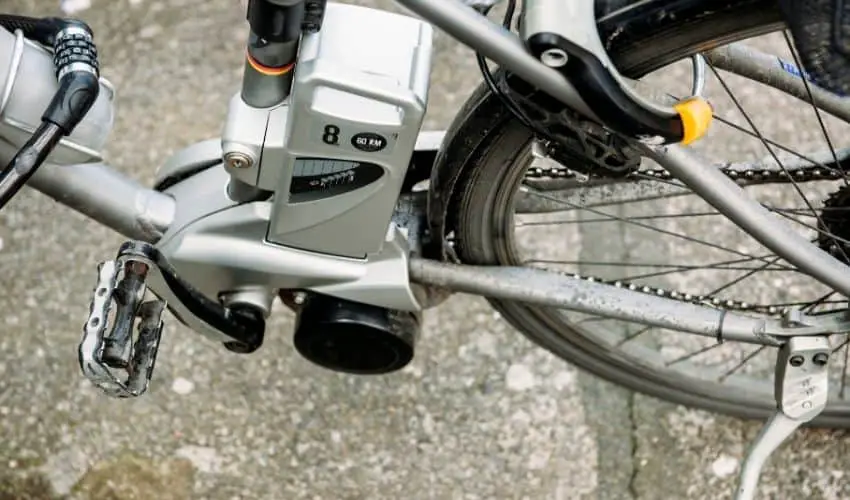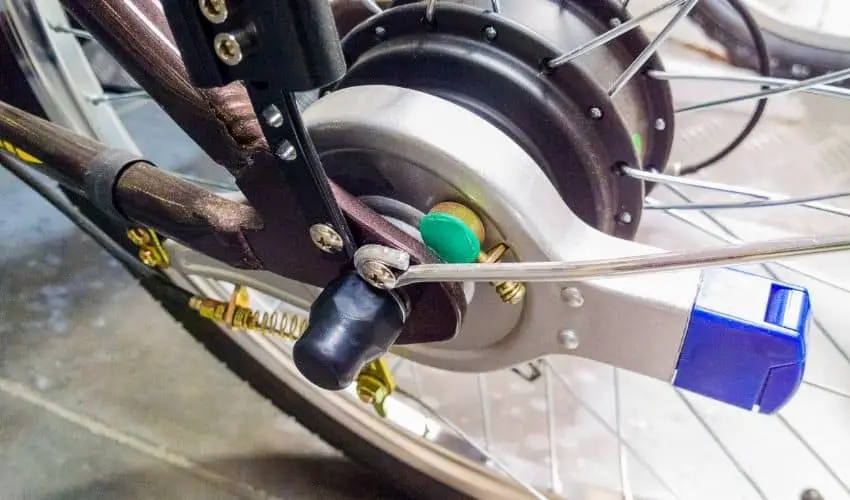Wondering, “How long does an electric bike motor last?”
This is one of the most frequently asked questions by people intending to purchase an e-bike for regular use. Considering the recent hype, you may see an electric bike as an investment. It is the perfect alternative to traditional bikes, as it takes you farther with more speed and less effort.
But you wouldn’t want to see your investment going down the drain in just a few months, right?
You may like How to Turn Your Bike into an Electric Bike: A DIY Guide and How Fast Can Electric Bikes Go? and How Long Does a Battery Last on an Electric Bike?
This e-bike guide will answer all your questions regarding the motor’s longevity and maintenance.
So, let’s get started!
How Long Does an Electric Bike Motor Last?
Generally, electric bikes function well for 3-5 years. After this, the motor will start to lose its efficiency if you didn’t follow a proper maintenance regimen in the first place. You may also notice a significant decline in the performance of the battery.
Essentially, the better you take care of your electric bike motor, the longer it will last. This goes for all parts of the bike. However, the motors of e-bikes usually last longer than any other part.
Wondering how?
Well, if you remember how electric bikes work, the motor isn’t supposed to work all the time. It doesn’t carry a lot of weight either. It operates only when you work the pedal. Besides, it is not responsible for pushing the bike forward; it simply helps you pedal.
Considering this, most electric bike motors can last for a minimum of 10,000 miles. Do you know what this means? You’ll have to get a replacement battery, chain, brakes, and almost all other parts of the e-bike except the frame itself before you have to worry about replacing the motor.
That being said, you still need to take proper care of your electric bike motor in order to extend its lifecycle. Before we move on to e-bike motor maintenance, let’s discuss the three main types of electric bike motors.

Read Electric Bike vs Petrol Bike
Types of Electric Bike Motors
Below are the three types of motors used in electric bikes.
1. Direct Drive Hub Motor
This type of motor is mounted on the front or back wheel of the e-bike. It uses magnets to create propulsions inside the hub and stator windings connected to the axle.
Apart from the bearings, there are no moving parts in the direct drive hub motor. This significantly increases the durability of the motor.
If your electric bike has a direct drive motor, you’ll have to look out for rust and overexposure to heat. If you run too much power through the motor, its components can get overheated and melt. To avoid this, you should consider installing a properly assessed and adjusted battery, controller, and motor setup.
Please note that you’ll have to keep your direct drive motor protected from water in wet climates and during the rainy season. Keeping it dry is the key to extending the lifespan of the bearings and other parts of the motor.
In case you end up riding the bike in the rain, make sure you dry the motor out properly. One way to go about this is by drilling tiny holes in the motor casing to allow water and vapors to escape the motor region as you ride.
2. Mid-Drive Motor
Connected to the crank, a mid-drive motor is supposed to power the bike’s chain directly. As you may have deduced, this type of motor exerts extra pressure on the sprockets, drive chain, and derailleur system. It is because both you and the motor will be applying force to the same area.
While you can sustain 100 watts of power at max, a mid-drive motor is capable of sustaining over 250 watts. The additional pressure can cause the motor components to wear out faster than usual.
This is why you may see that most e-bikes with a mid-drive motor come with upgraded chains. If you’ve used an e-bike conversion kit or a DIY method to turn your regular bike into an e-bike, you may have to deal with the issue of shorter chain life.
3. Geared Hub Motor
The spinning speed of the geared hub motor is higher than a direct drive motor. The gears in this motor transfer the energy to the wheel. The high speed of the motor is converted into torque, which is then used for climbing slopes and steep surfaces.
That being said, the gears create friction, which may shorten the lifespan of a geared hub motor. Moreover, you’ll have to replace the gears after traveling 3,000 to 10,000 miles.
So, if you’re a daily commuter who plans on using an electric bike with a geared hub motor for running errands and traveling to and from work, you can expect the gears to need replacement 2-3 times over the bike’s life.
One topic closely connected to the lifespan of electric bike motor is the lifespan of the battery.
Read How to Make a Bike Seat More Comfortable
How Long Does an e-Bike Battery Last?

As you know, almost all components of an e-bike wear out after some time, depending on their usage or the number of miles you’ve traveled on the bike.
Unfortunately, the battery of the bike loses its efficiency simply with time as well with little to no use. For instance, if you buy a battery and keep it aside for a year, you’ll see a noticeable difference in its performance.
Calculating an e-Bike’s Battery Life
You’re supposed to calculate your electric bike’s battery life in charge cycles. Basically, the number of times a battery can be fully charged (from 0 to 100%) before its efficiency takes a hit and it loses its function determines the longevity of the battery.
In general, an electric bike can undergo hundreds of charging cycles before it no longer functions at all. But how can you know the exact number of the charging cycles?
Several factors, including the type and level of care of a battery, affect the number of its successful charging cycles. Electric bikes are usually seen to last 3-5 years with efficient use.
Battery Type
While you can certainly extend the lifecycle of an electric bike’s battery with proper care and maintenance, it is not possible for you to change the type of battery because each type has a different expectancy.
Below are the most common types of batteries available out there.
- Lithium battery
- Nickel battery
- Lead battery
Lithium batteries generally offer the highest charging cycles i.e., up to 1,000 cycles. On the other hand, nickel and lead batteries may offer 500 and 300 charging cycles respectively.
Disclaimer: The charging cycles of the batteries mentioned above is only an estimation based on the information shared by the manufacturer. The numbers may vary depending on the quality of the battery.
You may like How to Charge an Electric Bike Battery.
How to Take Good Care of Your Electric Bike
Want to prolong the lifespan of your electric bike?
You must take special care of your e-bike. Follow the maintenance tips below to keep the battery and motor in good shape throughout the bike’s lifespan.
1# Avoid Overheating the Battery
The battery performance of an electric bike can be influenced by various environmental factors. One of the critical factors that affect the battery’s shelf life, charging cycles, and voltage control is temperature.
Always remember, a cool battery is a happy battery. If you want your bike’s battery to last longer, you must avoid exposing it to high temperatures.
An easy way to go about this is by storing it in a place where there is no direct sunlight. Ideally, try to keep it in a room with a temperature ranging between 65 and 900 F.
2# Always Store a Partially Charged Battery
You must avoid storing a fully charged battery, as this may negatively affect the battery’s recoverable capacity. This habit may also cause most batteries to slowly lose their efficiency over time.
Once the voltage drops below a certain point, it may cause irreparable damage to the battery, depending on how long you’ve been using it.
Whenever you have to store your bike’s battery for extended periods, make sure it’s not fully charged or extremely low on battery. Keep it between 40 and 80%, and you’ll be good to go.
Apart from this, see if the battery comes with a lower storage setting. If it does, switch on this mode before storing the battery, and you won’t have to worry about any damage.
A good rule of thumb is to fully charge your bike’s battery and then go on a ride before storing it.
3# Say No to Regular Full Discharge
Fully discharging your electric bike’s battery on a regular basis can have detrimental effects on the battery’s health. These batteries don’t have a memory effect, so it’s not a good idea to frequently bring down your battery percentage to zero.
That being said, the occasional discharge of the battery is perfectly fine. If you want to extend the lifecycle of your electric bike’s battery, you should consider doing a partial discharge with regular top-ups.
4# Keep Your Electric Bike Clean
If you love your e-bike, you’d naturally want to take care of it and keep it clean. The condition of your bike says a lot about your personality.
Cleaning an e-bike may seem like a simple task. However, there are a few things you must know if you’ve never washed one before. With e-bikes, there is such a thing called ‘going overboard with cleaning’.
For starters, you may be tempted to use a high-pressure washer for deep cleaning your bike. However, you must know that it can cause water to enter critical parts, such as the bearings.
You may indulge in a thorough scrubbing session after off-roading on a muddy track. But never develop a habit of it, as it may negatively affect the performance of the bike’s suspension and drivetrain.
5# Keep All Moving Components Well-Lubricated
Frequent lubrication of the moving parts is necessary to avoid friction. If you fail to do this, excessive friction may result in premature wear and tear of the components. This will, of course, impact the overall performance of your bike and increase its lifespan.
6# Be Wary of Inflated Tires
Poorly inflated tires increase the chances of punctures. Hence, to keep your bike in good shape, you must keep its tires inflated.
Consider ditching the hand pumps and using a standing track pump that comes with a pressure gauge to inflate the tires. This will make the job easier and less time-consuming.
That being said, you must determine the PSI on your bike’s tire in order to find out how much air you should be putting in for the best results.
7# Keep an Eye on the Bolts
It is not uncommon for bolts to loosen up on their own over time. If gone unnoticed, this may exert unnecessary pressure on different components of your electric bike, resulting in faster wear and tear.
To prevent this problem, make it a point to check all the bolts regularly. If you find any bolt wiggling loose, you can tighten or replace them if necessary.
8# Store Your e-Bike Properly
Where do you keep your electric bike when it’s not in use?
The storage location of your bike also determines its lifespan. If you tend to leave your bike outside, it’s time to change your habit.
Outdoor storage means direct sunlight, higher temperatures, and added moisture. All these factors can damage the components of your e-bike and shorten its lifespan.
Ideally, you should keep your bike indoors if you really care about it and want to make the most of it.
How to Handle Electrical Problems in Your Electric Bike

Are you experiencing electrical problems in your electric bike and don’t know how to fix them?
Consulting with a bike expert is the right thing to do. Ideally, you should get in touch with the dealer from whom you purchased the bike. They will be able to examine the bike, diagnose the problem, and suggest a viable solution.
If you don’t know anything about electric bikes, it is best not to take any electrical parts apart. Moreover, keep the plastic covers as is to prevent any damage to the internal components. You should leave everything on the e-bike technician because even a small blunder can invalidate warranties.
In case you want to take a look at the issue yourself, make sure you have a magnetic tray or some sort of container to keep all the bolts safe.
Another great practice is to lay all parts out in the same order you removed them just in case you can’t recall which part has to go next when putting it all back.
One thing to check before reaching out to the dealer is the electrical connectors. Sometimes, when you ride your e-bike on a rough surface and hit a hard bump, the power may cut off. You should also check the placement of the battery.
Oftentimes, a slight movement of the battery may result in a momentary loss of connection and you may get worried.
Sometimes, the solution is as simple as turning the bike on after switching it off for a few seconds. This trick works by resetting the controller. In this case, you must still take the bike to an expert for a quick inspection.
You may like the following electric bike articles:
- Electric Bike Vs. Hybrid Bike – Which One Should You Choose?
- How Much Cargo Can an eBike Carry in 2021?
- All You Need to Know About Shipping Electric Bikes
- Everything You Need to Know About Fat Tire Electric Bike Kits
- Check Out These 4 Best Big Cat Electric Bikes
- How to Choose an Electric Bike
- Best 1000 Watt Electric Bikes
Summing It Up
An electric bike serves as an excellent alternative for regular bikes. They are great for daily commutes, fun rides, as well as off-roading. An e-bike can definitely be an excellent long-term investment, given that you take proper care of it.
Now that we have answered your question, “How long does an electric bike motor last?” and given you some valuable tips to keep your bike in good shape for years to come, you should start taking care of your vehicle like it deserves!

I am Michael, an avid rider and bike expert. I am here to provide, biking tips and expert advice on in-depth bike reviews covering features, capabilities, price range, and much more. Specially on electric bikes, mountain bikes, road bikes, etc. I will provide honest product reviews, along with expert advice on purchasing, training, and maintenance. Check out my complete profile.